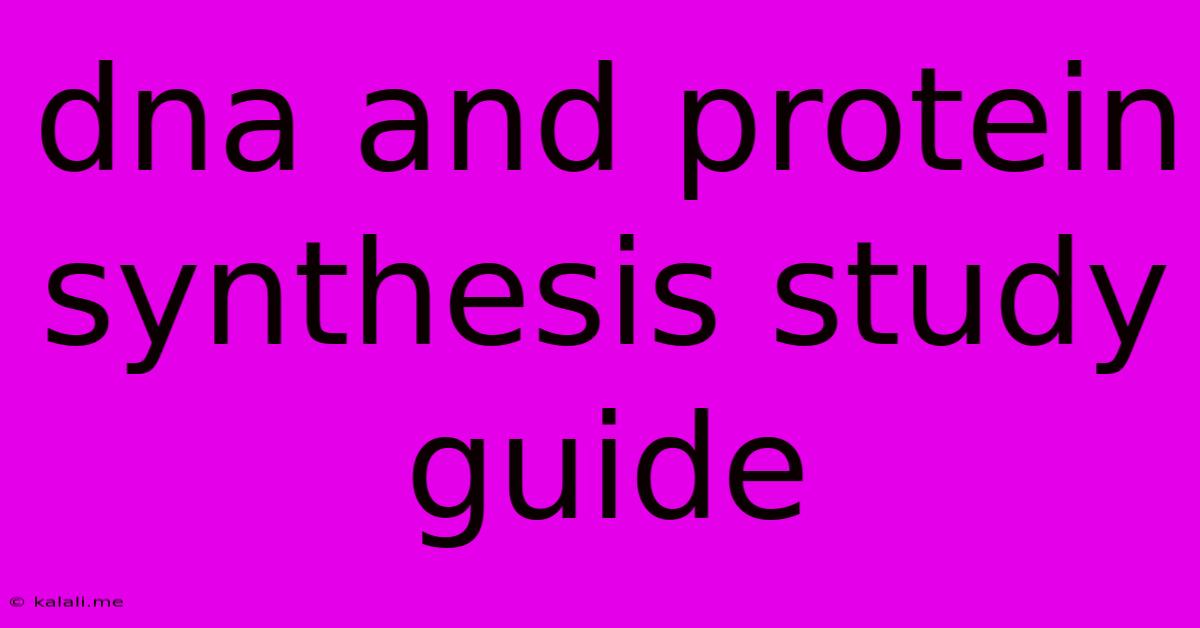Dna And Protein Synthesis Study Guide
Kalali
May 09, 2025 · 3 min read

Table of Contents
DNA and Protein Synthesis Study Guide: A Comprehensive Overview
Understanding DNA and protein synthesis is fundamental to grasping the intricacies of molecular biology. This study guide provides a comprehensive overview of these crucial processes, covering key concepts, definitions, and important steps. This guide will help you master the basics and prepare for exams or further study.
What is DNA?
DNA, or deoxyribonucleic acid, is the blueprint of life. It's a double-stranded helix composed of nucleotides. Each nucleotide contains a sugar (deoxyribose), a phosphate group, and one of four nitrogenous bases: adenine (A), guanine (G), cytosine (C), and thymine (T). The sequence of these bases determines the genetic code. Understanding DNA replication, the process by which DNA makes an exact copy of itself, is critical to understanding inheritance and cell division. This process involves several key enzymes like DNA polymerase and helicase.
Key DNA Concepts:
- DNA Replication: The semi-conservative process of creating an identical copy of a DNA molecule.
- Transcription: The process of creating an RNA molecule from a DNA template.
- Translation: The process of synthesizing a protein from an mRNA molecule.
- Genome: The complete set of an organism's DNA.
- Gene: A specific sequence of DNA that codes for a particular protein or RNA molecule.
- Chromosomes: Structures within cells that carry genetic information in the form of DNA.
DNA Replication: A Deeper Dive
DNA replication is a remarkably accurate process ensuring the faithful transmission of genetic information from one generation to the next. The process begins with the unwinding of the double helix by enzymes like helicase, creating a replication fork. Then, DNA polymerase adds complementary nucleotides to each strand, resulting in two identical DNA molecules, each containing one original and one newly synthesized strand. This semi-conservative nature ensures genetic stability. Proofreading mechanisms within DNA polymerase minimize errors.
The Central Dogma: Transcription and Translation
The central dogma of molecular biology describes the flow of genetic information from DNA to RNA to protein.
Transcription: From DNA to RNA
Transcription is the process of synthesizing an RNA molecule from a DNA template. The enzyme RNA polymerase binds to a specific region of DNA called the promoter and unwinds the double helix. It then synthesizes a complementary RNA molecule, using ribonucleotides instead of deoxyribonucleotides. In RNA, uracil (U) replaces thymine (T). The resulting RNA molecule, called messenger RNA (mRNA), carries the genetic code from the nucleus to the ribosomes in the cytoplasm. Different types of RNA exist, each with its own function, including ribosomal RNA (rRNA) and transfer RNA (tRNA).
Translation: From RNA to Protein
Translation is the process of synthesizing a protein from an mRNA template. This occurs in the ribosomes, which are complex molecular machines composed of rRNA and proteins. Transfer RNA (tRNA) molecules carry amino acids to the ribosome, where they are linked together to form a polypeptide chain according to the sequence of codons (three-nucleotide units) in the mRNA. This process involves codon recognition by tRNA anticodons and peptide bond formation. The completed polypeptide chain folds into a specific three-dimensional structure to become a functional protein.
Mutations and their Effects
Mutations are changes in the DNA sequence that can alter the genetic code. These changes can range from single nucleotide substitutions (point mutations) to larger deletions or insertions. Mutations can have various effects, from silent mutations (no change in amino acid sequence) to missense mutations (change in one amino acid) and nonsense mutations (premature stop codon). Mutations are a source of genetic variation and drive evolution, but they can also cause genetic disorders.
Techniques Used to Study DNA and Protein Synthesis
Several techniques are used to study DNA and protein synthesis, including polymerase chain reaction (PCR) for amplifying DNA sequences, gel electrophoresis for separating DNA fragments, and various methods for protein analysis.
This study guide provides a foundation for understanding DNA and protein synthesis. Further research and exploration of specific details within each process are highly recommended for a complete grasp of the subject. Remember to use diagrams and practice problems to solidify your understanding. Good luck with your studies!
Latest Posts
Related Post
Thank you for visiting our website which covers about Dna And Protein Synthesis Study Guide . We hope the information provided has been useful to you. Feel free to contact us if you have any questions or need further assistance. See you next time and don't miss to bookmark.